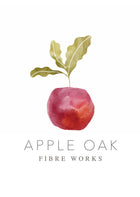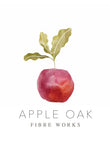Variety Trials: Shades of Blue by Tristan Lienhard
Though late spring and early summer remained cool and wet this year, by July 12th, there was enough growth on the woad to do a first harvest. An interesting thing to observe, was that 1 of the varieties bolted consistently across all four replicates. This automatically excluded that variety from the trials, as pigment is extracted from the first years rosette of leaves, and once bolting, the plant produces very little leaf and will not come back when harvested. Another of the varieties performed very poorly, and though we kept it in the trials in case it produced an exceptional blue, agronomically it was a non-runner.
We proceeded to harvest each variety into separate crates - recombining all 4 replicates from the randomised blocks of that variety together. In total we harvested 47.05kg of leaves with productivity varying by variety from 333g to a whopping 4.35kg.
Once the harvest was completed, we took the crates back to the workshop as fast as possible to carry out the extraction process, before the leaves wilted and the pigment started breaking down.
At the workshop we had buckets prepared, with the number of each variety written on them, and pre-filled with exactly 5l of water. We weighed out 150g of woad leaves of each variety and put them into their corresponding buckets. After that we blended the mixture with hand blenders, before introducing a 50g hank of pure wool yarn, a 2g sample piece of Habotai silk and a 22g silk scarf .
Each person had 2 buckets, and went on to gently stirring the mixture for exactly 20 minutes, to ensure even contact of fibres to water. This method is called the cold Japanese extraction method, and with these ratios we aimed to reveal the dye concentration of each variety.
After 20 minutes we washed and spun each variety separately, and made sure they ended up on the correct pre-numbered drying rack.
The differences where immediately clear with some varieties producing deep vibrant blue, while others were very pale.
The participants in this activity each went home with a lovely fresh woad hand dyed scarf.
After harvesting woad, it is extremely important to give the plants a good feed, which I did with chicken manure pellets. It is also important to thoroughly water them every second day for 6 days.
Below you can see the indigotin pigment on the cut ends of the stems, 3 days after harvest, along with new growth already starting to appear.
A month later, on the 12 of August, we carried out exactly the same process of harvesting and extracting, to test each variety for dye content at second harvest. The weather had been much warmer for the month of July, and after 31 days of growth, we harvested almost two and a half times the amount of leaves; weighing in at 116.5kg. The lowest yielding variety was the same in both harvests, this time coming in at 560g, while the most productive variety was a different this time around and weighed in at 9.91kg.


This extraction was done with the students of our 1 year online Professional Natural Dyers Course, and together we analyse all the samples from both extractions, ordering them into a graded scale of blue intensity from weakest to strongest.
It was an interesting exercise and the many eyes made light work of it, with 4 varieties clearly standing out as the best. In the photo below we have graded the bottom row - which was the August harvest - from palest to darkest, with the top row being the July harvest, and being organised to match the variety number of the August harvest. In this layout it is interesting to observe that the 2nd, 5th and 8th samples had very good blue content in the first harvest, but not so in the second harvest. We shall be testing those varieties again in a third harvest to see if it was human error or those varieties consistently produce less pigment later in the year.
The 3 separate samples on the far right are from Chinese woad (Isatis indigotica) - though this distinction is an area of conflict among botanists (see this article) - to us there was a clear difference in the quality and intensity of blue in the samples, and in the growing habits of the plants out in the field.

These variety trials have been a very interesting, if labour intensive exercise. Though there is still some analysis to be done on the various varieties in terms of productivity and suitability for seed saving in the Irish climate, I feel that we are getting closer to identifying a few good varieties to make available as seed in our shop.
In terms of the Weld Variety trials, we have had some interesting surprises. As you can see in the picture below a lot of the varieties bolted in their first year, which is not supposed to happen, as they are a biennial. One of the varieties has reliably bolted across all 4 replicates with an occurrence of 97.5%.
This has got me somewhat excited, because, if this variety has good dye content as well as reliably going to flower in its first year, natural dyers will be able to obtain colour from weld in one year rather than 2. To this end we have harvested the different varieties separately and will be testing them for dye content, to see if this hypothesis is correct. Some of the varieties were very inconsistent with their flowering, while 2 varieties have remained true biennials, and have not put up a single flower spike. Interestingly enough, one of the varieties staying as a true biennial, came from Bishops Court in county Down where it has been grown for centuries, thereby maybe demonstrating true adaptation to the Irish climate
The Persicaria trials at home are growing away nicely, revealing considerable morphological differences and some differences in dye content showing up, through a leaf pounding test. Though we will also do a cold extraction test on them, to further explore dye content.
And finally the madder varieties are also growing very well, after being potted on into 5 litre pots in mid July. I am looking forward to revealing the differences in dye content of each variety, though it will be another 2 years until the roots are mature enough to harvest.
The interesting detail that seems to be appearing, is that 6 of the 7 varieties are clumping; meaning that the growing point is central to the plant and does not spread. Where as, 1 of the varieties, appears to be spreading through underground roots and putting up shoots in multiple areas in the pot. More to follow on this....... in the Natural Dyers & Growers Academy Co~Lab rooms.
If you are interested in gardening and natural dyeing, you might like to join our ever growing community in the Natural Dyers & Growers Academy Co~Lab rooms. Here we share , exchange and explore with others everything to do with organic gardening, growing, seed saving, professional natural dyeing practices, sustainable studio development, individual plant forums, live chats & videos and so much more. To sustain the platform & its maintenance, we charge €45 a year annually.
Thank you for reading!


















Thank you Linnette! Feel free to get in touch any time :)
Soy artista textil y utilizo mis propias telas teñidas, me interesa mucho lo que ustedes hacen.
Vivo en San José de Costa Rica.
Saludos cordiales
Leave a comment